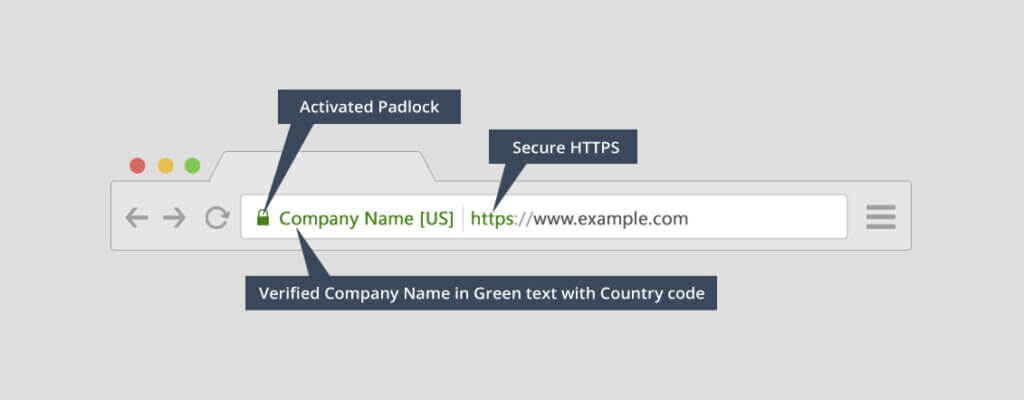If you’re skimming: all public-trusted SSL/TLS certificates give you the same encryption. What differs is identity vetting, support/tooling, and sometimes a warranty from the certificate authority (CA).
Browsers no longer show the old EV “green bar” or company name in the address bar; users just see a lock/tune icon and the domain.

Below I’ll walk you through the certificate types, where free options like Let’s Encrypt shine, and when paying actually makes sense.
The three validation levels (and what users really see)
DV (Domain Validation)
The CA proves you control example.com — nothing more. It’s fast and fully automated. In the browser UI, DV looks the same as OV or EV today. For most websites, DV is enough.
OV (Organization Validation)
Adds business identity checks (legal existence, address, phone, etc.). Visitors won’t see your company name in the address bar anymore, but it appears in the certificate details. This can matter for procurement, B2B trust, or internal policy.
EV (Extended Validation)
The most extensive identity vetting (formal, documented checks). Historically showed the company name/green bar. That UI is gone in modern Chrome, Firefox, and Safari; EV now surfaces only in the certificate’s details panel. If you need EV, it’s usually because policy says so, not because users notice a visual difference.
Key point: DV/OV/EV all deliver the same TLS encryption strength at the same protocol/cipher settings. Paying doesn’t make HTTPS “stronger”; your server config does.
Free certificates (Let’s Encrypt): what you actually get
- DV-only, automated issuance/renewal. Default lifetime is 90 days (auto-renew at ~60 days is best practice).
- SAN / multi-domain support: up to 100 names per certificate (hosters may impose lower caps).
- Wildcard support (
*.example.com) is available, but it requires DNS-01 validation (API access to your DNS makes this easy). - Chain/trust: Let’s Encrypt now relies on its ISRG Root X1 (the old cross-sign expired in 2024). Only very old or unusual clients have issues.
For 95% of sites — blogs, marketing sites, SaaS front-ends, small stores — free DV with good automation is the right answer.
Paid certificates: what you’re really paying for
- OV/EV identity vetting (needed by some enterprises, fintech/government portals, or vendors’ security checklists).
- Warranty against mis-issuance by the CA (not against hacking your site). Warranties vary (often $10k–$1M+), are rarely claimed, and mostly protect end-users after a CA error. Treat it as a procurement checkbox, not a security control.
- Support & lifecycle tooling: dashboards, bulk management, enterprise automation, SLAs, and compliance reporting.
- Brand & ecosystem: some CAs (DigiCert, GlobalSign, Sectigo [formerly Comodo]) offer advanced PKI services beyond TLS.
Certificate lifetimes (today’s rules)
- Max public TLS lifetime: ~398 days (≈13 months) for any CA-issued server certificate since Sept 1, 2020. Multi-year “plans” just mean annual re-issuance. In the future, the plan is to reduce the TLS lifetime to ~47 days by 2029.
- Let’s Encrypt: fixed 90 days (by design, for security + automation).
Performance & security (don’t overthink the brand)
Speed and security are driven by protocols and keys, not by buying EV:
- Use TLS 1.3 for fewer round trips and faster handshakes.
- Prefer ECDSA keys (with RSA fallback if you must support older clients) for lighter CPU use.
- Keep ciphers sane and enable HSTS/OCSP stapling; monitor expiry with automation.
Whether your cert is free or paid, these server-side choices move the needle; the product tier does not.
When to choose what (clear scenarios)
Choose free DV (Let’s Encrypt) when:
- You run standard public websites or APIs and can automate renewals.
- You don’t have a written policy requiring OV/EV or a specific CA.
- You need SANs or a wildcard and have DNS API access for DNS-01.
Choose paid OV/EV when:
- A contract, regulation, or enterprise policy explicitly requires OV/EV identity vetting.
- You need a warranty for risk transfer/compliance (again: mis-issuance coverage only).
- You want human support, enterprise dashboards, and PKI features beyond plain TLS.
Step-by-step: set it up right
A) Free DV with automation
- Use your panel’s integration (cPanel/DirectAdmin/Plesk/cloud providers) to enable Let’s Encrypt and auto-renew.
- For wildcards, set up your DNS provider’s API and use DNS-01 in Certbot/acme.sh; renewals become hands-off.
- Configure TLS 1.3 and prefer ECDSA certificates (keep RSA as a backup for old clients).
B) Paid OV/EV with a CA or reseller
- Gather legal docs (business registration, address, phone). Expect callbacks/email checks.
- Plan for annual re-issuance (even on multi-year plans) and automate deploys via your CI/CD or load balancer.
- Don’t expect UI magic: your company name won’t appear in the address bar anymore.
Common myths — corrected
- “Paid certs are faster / more secure.” No. Encryption strength and performance depend on protocol/cipher/key type and server config, not DV vs. OV vs. EV.
- “EV shows my company name to users.” Not in modern browsers; details live behind the lock/tune icon.
- “Warranties protect me if I get hacked.” Warranties cover CA mistakes (mis-issuance), not site compromises or phishing.
Bottom line
If you value practicality over ceremony, use free DV with rock-solid automation and modern TLS settings. Pay for OV/EV only when your policy, contracts, or internal governance require verified organizational identity or you need the CA’s tooling/support.
The lock icon doesn’t care how much you paid — your configuration does.




Leave a Comment